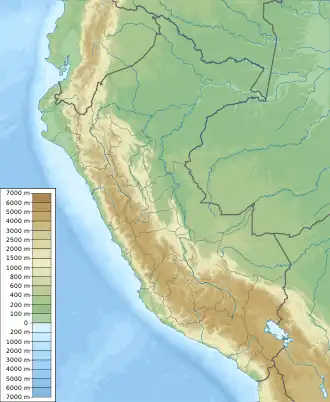 Panoramic view of Huaycán de Pariachi | |
 Shown within Peru | |
| Location | Huaycán, Lima |
|---|---|
| Coordinates | 12°00′44″S 76°49′58″W / 12.01222°S 76.83278°W |
| History | |
| Cultures | Ichma, Inca |
Huaycán de Pariachi is an archaeological site in Peru. It is located in Huaycán, Ate District, Lima.[1][2][3][4] It is located south of the Rímac River.
It was part of the Ichma culture and the Inca Empire.[5][6][7][8]
Chronology

Although its antiquity likely dates back to the Preceramic Period, the few studies conducted have confirmed occupations by the Ychma (Late Intermediate Period) and the Inca (Late Horizon).[1][7] The ZAMHP occupies approximately 60 hectares[9][10] across its three sectors, although most visits focus on the only restored structure, known as the Palacio[8][11] (Sector 1).
It was declared a Cultural Heritage of the Nation on October 10, 2000, through National Directorial Resolution No. 1189 issued by the then National Institute of Culture, now the Ministry of Culture.[7]
Description
Before the Spanish conquest, Huaycán de Pariachi was one of the main administrative centers of the middle Rímac Valley. During the Late Intermediate Period (900 - 1450 AD) the Ichma[12] had a very important local presence, which lasted until the Late Horizon (1450 - 1532 AD), when the Incas[9] arrived on the central coast and assimilated them.
Huaycán de Pariachi is divided into three sectors.[13][8][6]
Sector 1


Sector 1 is the largest and consists of the remains of an ancient population or llaqta (Pariacha, according to the Huarochirí Manuscript). This sector has two zones: spaces used as residences for the elite (Palaces;[13][8][6] one of them restored) and spaces used for other purposes (domestic, industrial, and ritual).
Architecturally, the restored Palacio is constructed using two techniques: rammed earth walls and stone and mud walls. It includes numerous spaces such as courtyards, open areas with benches, ramps, niches (not to be confused with niches carved into some walls, as some of them were used for funerary purposes during the colonial and republican eras), as well as numerous collqas[14][1][5] (deep circular storage deposits, some shaped like a bottle) used for storing food.
Sector 2
In Sector 2 (in front of the main entrance), a segment of an elevated walled road can be observed. This road was part of the network that formed the Qhapaq Ñan[15][16] during the Late Horizon. It connected Pariacha with other administrative centers in the valley, such as San Juan de Pariachi, Huanchihuaylas (now Santa Clara), Mama (now Ricardo Palma), and, through the Molle ravine pass, with Huaycán de Cieneguilla and the main Qhapaq Ñan road from Hatun Xauxa to Pachacamac in the Lurín Valley.
Sector 3
Sector 3 is separated from the previous two sectors and is located 1 km west of the entrance to Sector 1. It covers an area of 18 hectares within a perimeter of 553 m, adjacent to the Horacio Zevallos Housing Development. It presents structures with rammed earth walls, although they are in poor condition.
Restoration and investigations
Huaycán de Pariachi has not been fully investigated. However, numerous archaeologists have visited the site, including Dr. Julio C. Tello in the 1940s.[17] Arturo Jiménez Borja carried out restoration and conservation work in the 1970s.[18] Archaeological explorations requested by the city of Huaycán before the INC in 1985, helped to delimit its intangible area. In 2015, the Archaeological Research Project of the Ministry of Culture of Peru was carried out.
Images
References
- 1 2 3 "Zona Arqueológica Huaycán De Pariachi". Peruvian State. Retrieved 26 August 2023.
- ↑ "Sitio Arqueológico Huaycán de Pariachi". Google Travel. Retrieved 26 August 2023.
- ↑ "Museo de sitio en el Complejo Arqueológico Monumental Huaycán de Pariachi". Repositorio - University of Lima. Retrieved 26 August 2023.
- ↑ "Arqueología de Lima Huaycán de Pariachi". Repositorio - Ministry of Culture. Retrieved 26 August 2023.
- 1 2 "Zona Arqueológica Huaycán de Pariachi". deperu.com. Retrieved 26 August 2023.
- 1 2 3 "Zona Arqueológica Huaycán de Pariachi". terandes.com. Retrieved 26 August 2023.
- 1 2 3 "Ministerio de Cultura inicia proceso de Puesta en valor del complejo Huaycán de Pariachi". qhapaqnan.cultura.pe/. Retrieved 26 August 2023.
- 1 2 3 4 Gloria Medina. "Huaycán de Pariachi, zona arqueológica en el valle del Rímac". peruenvideos.com. Retrieved 26 August 2023.
- 1 2 Daniel Meza. "Reviving Huaycán—and the Community That Surrounds It". Sapiens. Retrieved 30 August 2023.
- ↑ "El 60% de las huacas de Lima está en riesgo de ser invadido". El Comercio (Peru). Retrieved 30 August 2023.
- ↑ "PALACIO EN EL TIEMPO". El Peruano. Retrieved 26 August 2023.
- ↑ "huaycán de pariachi - Ministerio de Cultura" (PDF). Peruvian State. Retrieved 26 August 2023.
- 1 2 "Huaycan de Pariachi". tripadvisor. Retrieved 30 August 2023.
- ↑ "Ministerio de Cultura pone en valor el complejo Huaycán de Pariachi". Andina (news agency). Retrieved 30 August 2023.
- ↑ "Camino prehispánico Pando". Dialnet. Retrieved 30 August 2023.
- ↑ "Diana Álvarez Calderón es nueva ministra de Cultura". Ifacca. Retrieved 30 August 2023.
- ↑ "DIAGNÓSTICO DE LA ZONA ARQUEOLÓGICA MONUMENTAL HUAYCÁN DE PARIACHI PARA ELABORAR UN PLAN DE ACCIÓN" (PDF). Repositorio - USMP. Retrieved 26 August 2023.
- ↑ "BAPUCP7 07 Villacorta - Revista - PUCP". Revistas - PUCP. Retrieved 26 August 2023.
